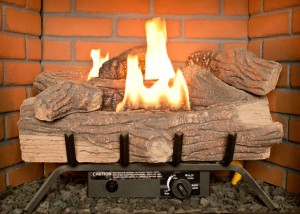Ventless fireplaces are an alternative to installing a regular fireplace for homeowners. They are realistic looking, and have minimum installation requirements. A vent-free fireplace does release emissions, and these are vented into a room inside your home. As such, it is critical that homeowners follow simple safety rules when using a ventless fireplace. The two primary concerns on which homeowners must focus when using vent-free gas log sets are carbon monoxide levels and oxygen depletion. To help you determine if a ventless gas log set is right for you, we encourage you to continue reading.
Vent-free gas heating products are available in many designs for varied applications, personal tastes, and price points. When installed, these units are fixed (meaning you cannot move them around) and can be fueled by either propane or natural gas, which is determined by the primary heating fuel for your home (if you’re currently using either). Heat outputs ranging anywhere from 6,000-40,000 Btu/hr can be achieved by these units, more than enough to serve as supplemental heat in conjunction with your home’s primary heat source (i.e., your central heating system). Many modern units are available with thermostatic and/or remote controls to assist with the ease of operation.
ADDRESSING CARBON MONOXIDE CONCERNS
Dubbed the “silent killer,” carbon monoxide (CO) is a colorless, odorless, toxic gas that is undetectable by humans. Carbon monoxide detectors monitor CO levels in your home and alert you when the gas reaches dangerous levels to protect you from this lethal threat. It is recommended that homes that are heated with gas have multiple carbon monoxide detectors installed. It is vital to ensure that the detector contains an audible alarm and not just a color-changing strip, which prevents the need to constantly check it to see if elevated carbon monoxide levels are present.
If your carbon monoxide alarm goes off, turn off all fuel-burning appliances in your home and open as many doors and windows as possible to bring much-needed fresh air into the house. Move your entire family, including pets, to a safe area with abundant fresh air. Determine if anyone is suffering from headache, dizziness, nausea, irregular breathing, confusion and/or vomiting. Do not hesitate to call 911 to request help!
THE IMPORTANCE OF AN OXYGEN DEPLETION SENSOR (ODS)
When purchasing a vent-free unit, consider purchasing one that contains an ODS, as it monitors the levels of oxygen in the room containing your ventless fireplace; this is a much easier task now that manufacturing requirements have made the inclusion of an ODS mandatory. The oxygen depletion sensor sounds like a pretty technical thing, but in reality, it’s design is quite simple. If the carbon monoxide levels get higher inside the fireplace—before ever reaching the room—or if oxygen is lower for any reason, the valve de-magnetizes. The sensor immediately stops gas flow to the fireplace burner at this point. This type of valve is very reliable, with very few documented failures (even with tens of millions in use worldwide).
Vent-free gas log fireplaces are designed to be safe indoors without a chimney or other form of ventilation. They are easy to use and safe to enjoy. Like any other industry, there are companies who buy low-quality products, make up misleading names and mass-market cheap junk. You don’t need to worry about any of that with any of the quality products from Northeastern Fireplace & Design. If you’re less than thrilled with your current fireplace and/or you’re looking for a vent-free unit, we’ve got a cost-effective answer for you. Call us or come by today!

